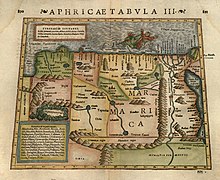Marmarica


Marmarica (
Libya is found in Africa and is located west of the Nile, more precisely west of the mouth of the Nile at Canopus. The Periplus of Pseudo-Scylax names the Adyrmachidae as the first people of Libya (Africa).
Marmarica proper was delimited towards the east by the escarpment of
Under the
The inhabitants of Marmarica were known generically as Marmaridae (Μαρμαρίδαι),[3] but they are given the special names of Adyrmachidae (Ἀδυρμαχίδαι) and Giligammae (Γιλιγάμμαι and Γιλιγάμβαι) in the coastal districts, and of Nasamones (Νασαμῶνες) and Augilae (Αὔγιλαι and Αὐγιλίται) in the interior. The Adyrmachidae are said to have differed considerably from the nomadic tribes of the country, strongly resembling the Egyptians. The territory south of the Libyan Nomos was inhabited by the Ammonii (Ἀμμώνιοι), centered on the celebrated and fertile oasis of Ammon (Siwa)
Both Cyrenaica and Marmarica were included in the
Episcopal sees
Ancient episcopal sees of the Roman province of Marmarica or Libya Inferior listed in the Annuario Pontificio as titular sees:[4]
For the sees of Libya Superior see Cyrenaica.
See also
- North Africa during Antiquity
- Butnan District
- Matrouh Governorate
- Libyan Desert
References
- ^ Riemer, Heiko (2013-01-01). Desert road archaeology in ancient Egypt and beyond. Heinrich-Barth-Institut. p. 152.
- ^ Mattingly, D. (30 July 2019). "Places: 716595 (Marmarica)". Pleiades. Retrieved July 30, 2019.
- ^ Pausanias, Description of Greece, 1.7
- ISBN 978-88-209-9070-1), "Sedi titolari", pp. 819-1013
External links
- Charles Anthon, A system of ancient and mediæval geography for the use of schools and colleges, Harper & brothers, 1855, 722-224.
- George Kish, A Source book in geography, Harvard University Press, 1978, ISBN 978-0-674-82270-2, p. 24.
- Leonhard Schmitz, A manual of ancient geography, Blanchard and Lea, 1857, 383-384.

